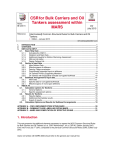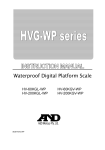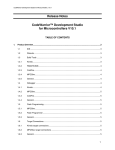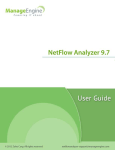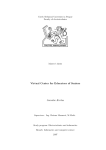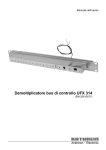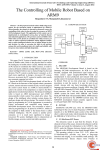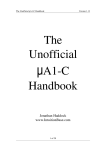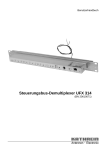Download Cyclone
Transcript
Credit where credit is due …
Cyclone
A Safe Dialect of C
CMSC 631
Fall 2006
1988? 2006?
• “In order to start copies of itself running on
other machines, the worm took advantage of
a buffer overrun...
•
...it is estimated that it infected and
crippled 5 to 10 percent of the machines on
the Internet.”
• More than 15 years later, nearly half of CERT
advisories involve buffer overruns, format
string attacks, and similar low-level attacks.
Low-level, but unsafe
• Must bypass the type system to do even simple
things (e.g., allocate and initialize an object)
• Libraries put the onus on the programmer to do the
“right thing” (e.g., check return codes, pass in large
enough buffer)
• For efficiency, programmers stack-allocate arrays of
size K (is K big enough? does the array escape
downwards?)
• Programmers assume objects can be safely recycled
when they cannot, and fail to recycle memory when
they should.
• It’s not “fail-stop”-errors don’t manifest themselves
until well after they happen (e.g., buffer overruns.)
• Cyclone is a research language, the
product of many collaborators:
–
–
–
–
Greg Morrisett, Yanling Wang (Harvard)
Dan Grossman (Washington)
Nikhil Swamy (Maryland)
Trevor Jim (AT&T)
The C Programming Language
• Critical software is often coded in C
– device drivers, kernels
– file systems, web servers, email systems
– switches, routers, firewalls
• … most arguably because it is low-level
– Control over data structure representations
– Control over memory management
– Manifest cost: good performance
What about Java?
• Java provides safety in part via:
– hidden data fields and run-time checks
– automatic memory management
• Data representation and resource
management are essential aspects of
low-level systems
1
Cyclone
A safe, convenient, and modern language
at the C level of abstraction
• Safe: memory safety, abstract types; fail-stop
• C-level: user-controlled data representation and
resource management, easy interoperability,
“manifest cost”
• Convenient: may need more type annotations, but
work hard to avoid it
Outline
• Status
• How Cyclone handles pointer errors
– Spatial Errors
– Temporal Errors
• Programming Experience
• Performance Analysis
• Modern: add features to capture common idioms
“New code for legacy or inherently low-level systems”
Status
• >110K lines of Cyclone code
– 80K compiler, libraries
– 30K various servers, applications, device drivers
• gcc back-end (Linux, Cygwin, OSX, LEGO, …)
• User’s manual, mailing lists, …
• Still a research vehicle (though winding down)
Projects using Cyclone
• Open Kernel Environment [Bos/Samwel,
OPENARCH 02]
• MediaNet [Hicks et al, OPENARCH 03]
• RBClick [Patel/Lepreau, OPENARCH 03]
• STP [Patel et al., SOSP 03]
• FPGA synthesis [Teifel/Manohar, ISACS 04]
• O/S class at Maryland [2004-2005]
What is a C buffer overflow?
#include <stdio>
int login() {
What happens if the user types
char user [100];
In something that’s more than
100 characters?
printf(“login: “);
scanf(“%s”,&user);
… // get password etc.
}
Calling scanf()
Stack grows
downward
32 bits
int login() {
char user [100];
printf(“login: “);
scanf(“%s”,&user);
}
login retaddr
24
…
1
user:
0
Buffer indexes proceed
upward
“%s”
2
User types login
int login() {
char user [100];
login retaddr
E A D
!
user:
1
H E L L
0
user:
int login() {
char user [100];
printf(“login: “);
scanf(“%s”,&user);
24
…
O
user:
}
D A
1
H E L L
0
“%s”
printf(“login: “);
scanf(“%s”,&user);
24
}
D A
1
H E L L
0
“%s”
Stack smashed!
!
!
…
O
“%s”
E A D
E A D
}
D A
int login() {
char user [100];
D
login retaddr
printf(“login: “);
scanf(“%s”,&user);
24
…
O
101st character …
Can make the
return address
point anywhere,
including into the
buffer.
Two kinds of Pointer Errors
• Spatial
– Dereferencing outside of a legal memory
buffer, possibly at the wrong type
– Abstraction-violating attacks in this
category
• Temporal
– Dereferencing a pointer after the pointedto buffer has been freed
Abstraction-violating Attack
• Language and library abstractions may
not be enforced
– Array accesses, pointer dereferences,
type casts, format strings “trusted” by the
compiler
• Other attacks exploit this fact
– Heap-based buffer overruns
– Format string attacks
Preventing Spatial Errors
• Don’t allow dereferencing a pointer
unless compiler can prove it’s safe
– Often too conservative
• Prevent dereferencing with dynamic
checks
– May be able to eliminate some or all of
these with static analysis, or programmerprovided type annotations
– Safety first; then tune performance
3
Thin Pointers
Thin Pointers
A “thin” pointer (one word)
p
Only dereference permitted,
no bounds check needed
p
H E L L O
H E L L O
*p
p = NULL;
*p
*p
p = NULL;
*p
Thin Pointers
Thin Pointers
May be null
p
Requires a null check if so
p
H E L L O
H E L L O
*p
p = NULL;
*p
*p
p = NULL;
*p
Thin Pointers
p
Thin Pointers
p
H E L L O
Types and qualifiers for more flexibility and/or fewer checks
char *p;
char * @notnull p1;
// illegal: p1=NULL; p1=p
char * @notnull @numelts(6) p2; // illegal: p2=p1
H E L L O
Shorthand
char *p;
char @ p1;
char @{6} p2;
4
Fat Pointers
Fat Pointers
A “fat” pointer; has run time
bounds: 3-word representation
Pointer arithmetic OK
H E L L O
q:
H E L L O
q++;
q[0]
q--;
q--;
q[0]
c f b
q:
q++;
q[0]
q--;
q--;
q[0]
c f b
Fat Pointers
Fat Pointers
Bounds check on dereference
H E L L O
q:
H E L L O
q++;
q[0]
q--;
q--;
q[0]
c f b
q:
q++;
q[0]
q--;
q--;
q[0]
c f b
Fat Pointers
Fat Pointers
Dangling pointers OK ...
… caught on dereference
H E L L O
q:
c f b
H E L L O
q++;
q[0]
q--;
q--;
q[0]
q:
c f b
q++;
q[0]
q--;
q--;
q[0]
5
Fat Pointers
Fat Pointers
H E L L O
q:
c f b
H E L L O
q++;
q[0]
q--;
q--;
q[0]
Types and qualifiers
char * @fat q;
Thin Pointer, Dynamic Bounds
q:
q++;
q[0]
q--;
q--;
q[0]
c f b
Shorthand
char ? q;
Pointer Qualifier Summary
• @fat
p
H E L L O
len = 5
void foo(int len, char * @numelts(len) p) {
for (int i = 0; i<len; i++)
p[i] = …
}
Interfacing with libC
FILE *fopen(char * @notnull @zeroterm name,
char * @notnull @zeroterm mode);
int putc(char, FILE * @notnull);
… fgets(char * @zeroterm @numelts(len),
int len, FILE * @notnull);
Our buildlib tool easily generates platform
dependent headers with signatures like these
(programmer helps)
– rep. as a triple: {base, upper, curr}
– supports all C pointer ops
– but any dereference (may be) checked
• @notnull
– Obviates null check (compiler must prove)
• @numelts(n)
– Obviates bounds check (compiler must prove)
– Can refer to dynamic lengths
• @zeroterm
– Pointer is zero-terminated
Temporal Errors
pt *add(pt *p, pt *q) {
pt r;
r->x = p->x + q->x;
r->y = p->y + q->y;
return &r;
}
void foo() {
pt a = {1,2};
pt b = {3,4};
pt *c = add(&a, &b);
c->x = 10;
}
r's lifetime ends here!
so dereferencing c here
can cause problems...
typedef struct { int x; int y; } pt;
6
Preventing Temporal Errors
• Tracks object lifetimes by associating a
region with each pointer:
int* @region(`r)
– A pointer can only be dereferenced while
the region is still live. int *`r for short.
• Two basic kinds of regions
– A lexical block (I.e., an activation record)
– The heap (`H); has a global lifetime.
Region Polymorphism
void addTo<`r1,`r2>(pt *`r1 p, pt *`r2 q) {
p->x += q->x;
p->y += q->y;
addTo is parameterized by
}
regions for p and q.
the
addTo: ∀`r1. ∀`r2. (pt *`r1 × pt *`r2) → void
And this would be caught
`H
a lives in the heap region,
so &a has type pt @`H.
pt a = {1,2};
void foo() {
pt b = {3,4};
pt @`H aptr = &a;
pt @`foo bptr = &b;
addTo(&a, &b);
}
b lives in the activation
record of foo so &b has
type pt @`foo.
region inference can figure out the regions,
so the programmer doesn't have to write them
So this would go through...
This is standard parametric polymorphism:
pt *`H add<`r1,`r2>(pt *`r1 p, pt *`r2 q) {
pt r;
r.x = p->x + q->x;
r.y = p->y + q->y;
return &r;
region of r is `add, not
}
Simple Region Example
pt *`H add<`r1,`r2>(pt *`r1 p, pt *`r2 q) {
pt *r = malloc(sizeof(pt));
r->x = p->x + q->x;
r->y = p->y + q->y;
return r;
}
pt a = {1,2};
void foo() {
pt b = {3,4};
pt *`H c = add<`H,`foo>(&a, &b);
pt *`H d = add<`foo,`foo>(&b, &b);
c->x = 10;
}
On the other hand...
pt *`H add<`r1,`r2>(pt *`r1 p, pt *`r2 q) {
p->x += q->x;
p->y += q->y;
return p;
}
region of p is `r1, not `H
pt a = {1,2};
pt a = {1,2};
void foo() {
pt b = {3,4};
pt *`H c = add<`H,`foo>(&a, &b);
pt *`H d = add<`foo,`foo>(&b, &b);
c->x = 10;
}
void foo() {
pt b = {3,4};
pt *`H c = add<`H,`foo>(&a, &b);
pt *`H d = add<`foo,`foo>(&b, &b);
c->x = 10;
}
7
So we must be explicit
What has to be written is thus:
pt *`r1 add<`r1,`r2>(pt *`r1 p, pt *`r2 q) {
p->x += q->x;
p->y += q->y;
return p;
}
pt *`r1 add(pt *`r1 p, pt * q) {
p->x += q->x;
p->y += q->y;
return p;
}
pt a = {1,2};
pt a = {1,2};
void foo() {
pt b = {3,4};
pt *`H c = add<`H,`foo>(&a, &b);
pt *`foo d = add<`foo,`foo>(&b, &b);
c->x = 10;
}
void foo() {
pt b = {3,4};
pt * c = add(&a, &b);
pt * d = add(&b, &b);
c->x = 10;
}
The types say it all
pt * add (pt * p, pt * q);
pt *`r1 add (pt *`r1 p, pt * q);
Dynamic Allocation
• How can we be sure data is live?
• Can use a GC, or safe manual techniques
• GC-based
pt *`r2 add (pt * p, pt *`r2 q);
– Data allocated in heap is given region `H
char * @zeroterm `r
fgets(char *{len} @zeroterm `r,
int len,
FILE @);
– Conservative collector reclaims dead objects
– Simple, but little control over performance
• Region is always live; dereferences are always safe
Safe Manual Techniques
• Approach: generalize regions, track pointers
• New region kind: Arenas
– Dynamic allocation, but all objects freed at once
• And/or impose aliasing restrictions
– Can free individual objects using malloc/free or
reference counting if aliasing is tracked
• When writing apps, use GC first, tune as
necessary
– Can result in significantly improved memory
footprint and throughput
• Potentially significant memory overheads
• Pause times
• May not be feasible in some environments (e.g., Linux)
LIFO Arenas
• Dynamic allocation mechanism
• Lifetime of entire arena is scoped
– At conclusion of scope, all data allocated
in the arena is freed
– Like a stack frame, but permits dynamic
allocation
• Useful when caller doesn’t know how much
memory needed by callee, but controls
lifetime
8
LIFO Arena Example
FILE *infile = …
Image *i;
if (tag(infile) == HUFFMAN) {
region<`r> h; // region `r created
struct hnode *`r huff_tree;
huff_tree = read_tree(h,infile);
// dynamically allocates with h
i = decode_image(infile,huff_tree,…);
// region `r deallocated upon exit of scope
} else …
Example
Unique Pointers
• If object is known to have no aliases, it
can be freed manually
– Qualifier @aqual(\U), or \U for short
• An intraprocedural dataflow analysis
– ensures that a unique pointer is not used
after it is consumed (i.e. freed)
– treats copies as destructive
• one usable copy of a pointer to the same
memory
Temporary Aliasing
• Problem: Non-aliasing too restrictive
void foo() {
int *\U x = malloc(sizeof(int));
int *\U y = x;
// consumes x
*x = 5;
free(y);
// disallowed
// consumes y
*y = 7;
// disallowed
}
Alias Construct
extern void f(int *`r x);
// `r any region
void foo() {
int *\U x = malloc(sizeof(int));
*x = 3;
{ alias <`r>int *`r y = x;
// `r fresh
f(y);
// y aliasable, but x consumed
}
// x unconsumed
• Partial solution: Allow temporary,
lexically-scoped aliasing under
acceptable conditions
– Makes tracked pointers easier to use
– Increases code reuse
With inference
extern void f(int * x);
void foo() {
int *\U x = malloc(sizeof(int));
*x = 3;
f(x); // alias inserted here automatically
free(x);
}
free(x);
}
9
Reference-counted Pointers
• Aliasing qualifier \RC
– pointed-to data have hidden count field
• Aliasing tracked as with unique
pointers. Explicit aliasing/freeing via
`a *\RC`r alias_refptr(`a *\RC`r);
void drop_refptr(`a *\RC`r);
Summary
Region
Variety
Stack
LIFO
Heap
Unique
manual
single
GC
objects manual restricted
Refcounted
– Pointers into the heap freed by GC
– Pointers into LIFO arenas freed at end of scope
• Called a reap by Berger et al
• Can use tracked pointers to keys to permit
arenas to have non-lexical lifetimes
– Lifetime of arena corresponds to the lifetime of
the key
– Called dynamic arena
• Many different idioms could be hard to use
– Duplicated library functions
– Hard-to-change application code
• We have solved this problem by
– Using region types as a unifying theme
– Region (and aliasing) polymorphism
• E.g., functions independent of arguments’ regions/aliasing
– All regions can be treated as if lexical
• Temporarily, under correct circumstances
• Using alias and open (for dynamic arenas)
Some Application Experience
Boa
Cfrac
BetaFTPD
Epic
Kiss-FFT
MediaNet
Linux Drivers
CycWeb
CycScheme
• Tracked pointers can be freed manually,
with free or drop_refptr, or automatically
Ensuring Uniformity and Reuse
Allocation Deallocation
Aliasing
(objects) (what) (when) (objs)
static
whole exit of
ok
region
scope
dynamic
Dynamic
Interesting Combinations
Application Characteristics
web server
Prime factorization
ftp server
image compression
portable fourier transform
streaming overlay network
net, video, sound
web server
scheme interpreter
10
Experimental Measurements
• Platform
– Dual 1.6 GHz AMD Athlon MP 2000
• 1 GB RAM
• Switched Myrinet
– Linux 2.4.20 (RedHat)
• Software
–
–
–
–
C code: gcc 3.2.2
Cyclone code: cyclone 0.9
GC: BDW conservative collector 6.2α4
malloc/free: Lea allocator 2.7.2
Bottom Line
• CPU time
– I/O bound applications have comparable
performance
• All applications: at most 60% slowdown
– GC has little impact on elapsed time
• MediaNet is the exception
• Memory usage
– Using GC requires far more memory than manual
– Cyclone manual techniques approach footprint of
C original
Throughput (Webservers)
Throughput (MediaNet)
Memory Usage (Web)
Memory Usage II (Web)
11
Memory Usage III (Web)
Memory Usage (MediaNet)
(4 KB packets)
Other Apps (C vs. Cyc GC)
Other Apps (Cyc GC vs. no GC)
Things I didn’t talk about
Related Work: making C safer
• Modern language features too
–
–
–
–
Tagged unions and data types
Pattern matching
Exceptions
Allocation with new
• Porting tool
• Lots of libraries
• Compile to make dynamic checks possible
– Safe-C [Austin et al.], RTC [Yong/Horwitz], ...
– Purify, Stackguard, Electric Fence, …
– CCured [Necula et al.]
• performance via whole-program analysis
• less user burden
• less memory management, single-threaded
• Control-C [Adve et al.] weaker guarantee, less burden
• SFI [Wahbe, Small, ...]: sandboxing via binary rewriting
12
Related Work: Checking C
• Model-checking C code (SLAM, BLAST, …)
– Leverages scalability of MC
– Key is automatic building and refining of model
– Assumes (weak) memory safety
• Lint-like tools (Splint, Metal, PreFIX, …)
– Good at reducing false positives
– Cannot ensure absence of bugs
– Metal particularly good for user-defined checks
• Cqual (user-defined qualifiers, lots of inference)
Better for unchangeable code or user-defined checks
(i.e., they’re complementary)
Future Work
• Tracked pointers can be painful; want
– Better inference (e.g. for alias)
– Richer API (restrict; autorelease)
• Prevent leaks
– unique and reference-counted pointers
• Specified aliasing
– for doubly-linked lists, etc.
• Concurrency
More Information
Related work: higher and lower
• Adapted/extended ideas:
–
–
–
–
–
polymorphism [ML, Haskell, …]
regions [Tofte/Talpin, Walker et al., …]
safety via dataflow [Java, …]
existential types [Mitchell/Plotkin, …]
controlling data representation [Ada, Modula-3, …]
• Safe lower-level languages [TAL, PCC, …]
– engineered for machine-generated code
• Vault: stronger properties via restricted aliasing
Conclusions
• High degree of control, safely:
• Sound mechanisms for low-level control
– Checked pointers for spatial errors
– Variety of techniques for temporal errors
• Region-based vs. object-based deallocation
• Manual vs. automatic reclamation
• Region- and alias-annotated pointers
within a coherent framework
– Scoped regions unifying theme (alias,open)
– Polymorphism, for code reuse
MediaNet Data structures
• Cyclone homepage
http://cyclone.thelanguage.org
• Has papers, benchmarks, distribution
13
Other Details
Sharing Unique Pointers
• Can store unique pointers in nonunique containers
• Can we have unique pointers in nonunique containers? Options:
– Must use “swap” operator to extract
them, to ensure soundness of analysis.
– Don't allow them; norm in linear type
systems
– Track sharable containers
• Alias construct
– Like Walker/Watkins (and Wadler) let!
– Fresh region is crucial to soundness normal typing machinery ensures that
aliased pointers will not escape the scope.
– Swap out unique pointers
Tying it together:
Polymorphism
Swap to the rescue
• Goal: avoid writing slightly different
versions of the same functions
int *`U g = NULL; // cannot access directly
void init(int v) {
int *`U x = malloc(sizeof(int));
*x = v;
– One for unique pointers, one for lexicallyscoped region pointers, etc.
g :=: x; // atomically swap *x with *g
free(x);
• Approach: parametric polymorphism,
differentiated by kinds.
}
– Need to differentiate between generic
functions that operate on alias-restricted
pointers and freely-aliasable ones.
Unique-path access
restriction
Dynamic Arenas
Invariant: Only ever one (unique) path by
which to access a unique object at any
program point
• Unique and reference-counted objects
can be freed at any time
• Also want to be able to free an entire
arena at any time
void f(int *`U*`r x, int *`U*`r y) {
free(*x);
**y = 1; // error if *x == *y
}
• E.g., guarded types in Vault; restricts
container aliasing, and may not be thread-safe
x
`r
`U
– Not just at the conclusion of a scope; I.e.
want separate region allocation and
deallocation functions.
y
14
Dynamic Arena Approach
• Define a key as a unique or referencecounted pointer to a region handle
• Key lifetime corresponds with region
lifetime
Dynamic Arena Example
void f(struct DynamicRegion<`r> *`U k,
int *`r x)
{
{ region r = open k;
*x = 42;
bar(r,x);
– Freeing the key frees the entire region
• Open a region to use it within a lexical
scope
// `r live, k consumed
// `r no longer live, k unconsumed
// frees the key and the region
}
free_ukey(k);
}
– makes region live within scope
– consumes the key until done
Dynamic Regions API
• struct DynamicRegion<`r::R>
*`k::TR
– Pointer to a container (in region `k) for a
dynamic region `r. Called a key.
• new_ukey()
– Returns a key, where `r is fresh (wraps in
an existential), and `k is the unique
region.
• new_rckey()
– Similar, but `k is the ref-counted region.
Disadvantages
• Programmers have to make the lifetimes of objects
explicit:
– must put regions on return types
– must allocate objects within regions
– must pass region handles around.
• Regions lifetimes must be LIFO
– No easy way to handle objects with overlapping, nonnested lifetimes
• Constructing a region expensive if only allocates a
small number of objects
Dynamic Regions API
• region r = open k;
– Given k points to a DynamicRegion<`r>,
makes `r live in the ensuing scope (with handle
r), temporarily consuming k
• free_ukey(ukey)
– Frees the key and the region it contains
• new_rckey(rckey)
– Decrements the reference count on the key,
freeing it and the region if it goes to zero
Cyclone: where we stand
• Cyclone compiler
–
–
–
–
~100KL of Cyclone code
Bulk is the type-checker and dataflow analyses
Straightforward translation to C
Available for many architectures (Linux, BSD,
Irix, Cygwin, Sparc, etc.)
• Ports
– Libc and other libs (sockets, XML, lists, and more)
– bison, flex, web server, cfrac, grobner, NT
device driver … (~40KL total)
– Typically differ from original C by 5-15%
15
Growable Regions
Growable Regions
typedef struct List<`r> {
int head;
struct List<`r> *`r tl;
} *`r list_t<`r>;
typedef struct List<`r> {
int head;
struct List<`r> *`r tl;
} *`r list_t<`r>;
void foo(unsigned int i) {
region<`d> h {
list_t<`d> x = NULL, temp;
for (; i != 0; i++) {
temp = rmalloc(h, sizeof(struct List));
temp->head = i; temp->tl = x;
x = temp;
};
process(h,x);
}
}
void foo(unsigned int i) {
region<`d> h {
list_t<`d> x = NULL, temp;
for (; i != 0; i++) {
temp = rmalloc(h, sizeof(struct List));
temp->head = i; temp->tl = x;
x = temp;
};
process(h,x);
}
}
Growable Regions
typedef struct List<`r> {
int head;
struct List<`r> *`r tl;
} *`r list_t<`r>;
The “region<`d> h{...}”
introduces a new dynamic
region `d with handle h.
void foo(unsigned int i) {
region<`d> h {
list_t<`d> x = NULL, temp;
for (; i != 0; i++) {
temp = rmalloc(h, sizeof(struct List));
temp->head = i; temp->tl = x;
x = temp;
};
process(h,x);
}
}
Growable Regions
The list structure is
parameterized by a region
Growable Regions
typedef struct List<`r> {
int head;
struct List<`r> *`r tl;
} *`r list_t<`r>;
Objects can be allocated
into region `d using
rmalloc(h,...) where h is
a handle for the region.
void foo(unsigned int i) {
region<`d> h {
list_t<`d> x = NULL, temp;
for (; i != 0; i++) {
temp = rmalloc(h, sizeof(struct List));
temp->head = i; temp->tl = x;
x = temp;
};
process(h,x);
}
}
Unlike the stack, any
number of objects can
be placed in the region.
Growable Regions
typedef struct List<`r> {
int head;
struct List<`r> *`r tl;
} *`r list_t<`r>;
typedef struct List<`r> {
int head;
struct List<`r> *`r tl;
} *`r list_t<`r>;
void foo(unsigned int i) {
region<`d> h {
list_t<`d> x = NULL, temp;
for (; i != 0; i++) {
temp = rmalloc(d, sizeof(struct List));
temp->head = i; temp->tl = x;
x = temp;
};
process(h,x);
}
}
void foo(unsigned int i) {
region<`d> h {
list_t<`d> x = NULL, temp;
for (; i != 0; i++) {
temp = rmalloc(h, sizeof(struct List));
temp->head = i; temp->tl = x;
x = temp;
};
process(h,x);
}
}
Since this function is given the handle
for `d, it can allocate objects in there
too, or return results in that region.
The entire region is deallocated
at the end of its scope.
16
So Far: Advantages
• Type system makes sure that:
– can’t dereference a pointer to a freed object.
– can’t forget to free a region.
– supports some dangling pointers.
• Runtime system ensures that:
– region and object allocation are constant time.
– region deallocation is constant time – and faster than
individually free’ing the objects.
• So the approach is quite attractive for real-time
systems when compared to GC.
Example
struct conn *\RC cmd_pasv(struct conn *\RC c) {
struct ftran *\RC f;
int sock = socket(...);
f = alloc_new_ftran(sock,alias_refptr(c));
c->transfer = alias_refptr(f);
listen(f->sock, 1);
f->state = 1;
drop_refptr(f);
return c;
}
17





















